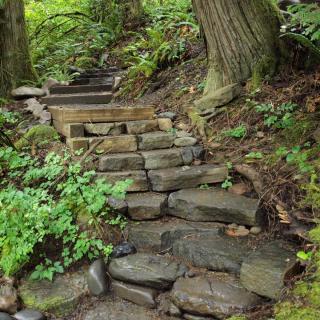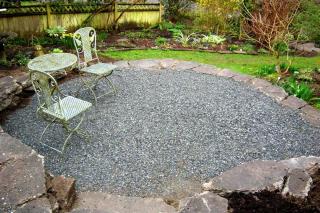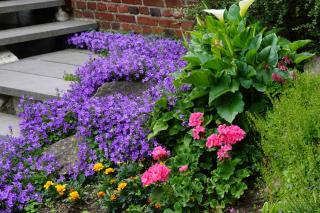

Is it hard to landscape a sloped garden? Actually, slopes and steep gradients can be an excellent opportunity to create a unique garden. Here are 5 tips to make the job easier.
Read also:
 The gradient of your garden is the most important factor for your garden. It is a measure of how inclined the plane is. If it’s only moderately sloped, say 5%, there won’t be much to do. At most a slightly winding path, with a few steps here and there. Make note, however, of where rain runoff goes: this impacts erosion. Also consider where the house is located along the slope.
The gradient of your garden is the most important factor for your garden. It is a measure of how inclined the plane is. If it’s only moderately sloped, say 5%, there won’t be much to do. At most a slightly winding path, with a few steps here and there. Make note, however, of where rain runoff goes: this impacts erosion. Also consider where the house is located along the slope.
Higher gradients are a completely different affair. Starting at 12%, with some natural slopes maxing out at nearly 25%, you’ll have to engage more means and get heavier work done. It then becomes critical to think things out before digging everything up to guarantee a result that’s pleasing to the eye and easy to live with.
 A walkway is an invitation to enter the garden, triggering the mind to release its worries in an environment filled with life.
A walkway is an invitation to enter the garden, triggering the mind to release its worries in an environment filled with life.
Discard any straight lines, and go for wavy, curvy paths instead. It’s much more beautiful and pleasurable. Wind the path back and forth, to make walking easier and reduce the slope artificially. It will help avoid having too many obstacles such as steps or steep slopes.
Overall, even though it might seem longer, it’s definitely easier to keep up and use.
To harmoniously wrestle control over a steep slope, it’s important to create flat landings at various intervals: one spot to rest on a bench, another for family picnics, and why not even one for a vegetable patch! Choose a full sun location for the latter.
 Make use of walls of every type: stone, wood, or even Corten® steel or wrought iron to hold soil back and keep it from rushing downhill. Vary styles and vegetation for each landing, so that in the end, you’ll feel like you’re traveling from one ambience to another.
Make use of walls of every type: stone, wood, or even Corten® steel or wrought iron to hold soil back and keep it from rushing downhill. Vary styles and vegetation for each landing, so that in the end, you’ll feel like you’re traveling from one ambience to another.
Lastly, remember to include viewpoints to turn the steep slope issue into a great asset: at the top, at the bottom, and half-way in between, each viewpoint shows the house and garden under a visually different perspective… perfect for finding the inner self!
If you’ve planned to flatten out a portion of your garden, consider installing a comfortable terrace near the house. A staircase on one or both sides leads to a lower level that might have a strikingly different purpose: an orchard, perhaps, or a vegetable patch? Or simply a patch of lush, green lawn.
 Rhizome plants, hands down. These plants have roots that will stabilize soil and hold it back.
Rhizome plants, hands down. These plants have roots that will stabilize soil and hold it back.
Pair them with ground cover plants that will break the fall of large raindrops and gently drip them to the ground. Plants that excel on mounds are also a good choice. Gypsophila, geranium, lavender, heuchera, daisy, erigeron, creeping juniper, meadowsweet, sedum… lots to choose from!
Also indulge into a few taller species to mark the view and disrupt what would otherwise feel like an excessively horizontal landscaping. Iris varieties like Dutch iris are tall, and their root system will anchor the soil to the slope.
As a result, you’ll have an eminently convenient, landslide-safe, and beautiful garden.
Claire Lelong-Lehoang
Set small composts at strategic spots up and down the slope in raised beds so you don’t have to lug plant material up and down, or simply chop trimmings up and lay them back down as a constantly renewing plant mulch.